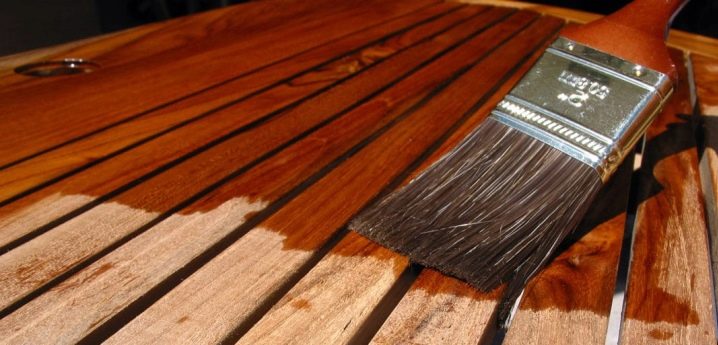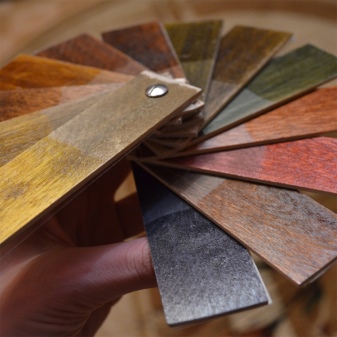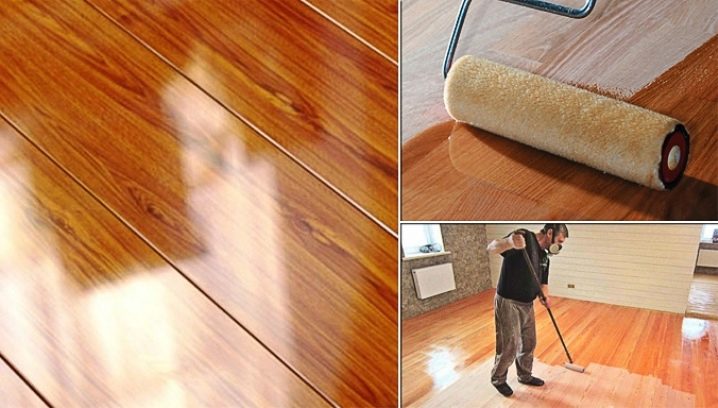Stain: types and subtleties of choice

Wood remains one of the most sought-after building materials, mainly due to its density, strength and environmental friendliness. At the same time, wooden surfaces and furniture do not tolerate moisture well and are susceptible to biological and atmospheric degradation.
To minimize negative influences, wooden objects are covered with a protective layer of varnish, paint or a special impregnation - stain.


Peculiarities
Stain is usually referred to as paint and varnish materials, but, unlike varnishes and enamels, it tints the surface without forming a visible film and emphasizing the woody texture. Wood fibers absorb the composition to varying degrees, due to which the natural pattern becomes more expressive, and in some cases, embossed.


This process is influenced by factors such as:
- Wood moisture... The solution penetrates better into damp and loose surfaces.
- Resinousness... Conifers are additionally degummed before staining.
- Density of wood... The higher it is, the worse the dye solution penetrates into it. Therefore, less dense areas, such as the spring part or sapwood, acquire a richer color than the kernel or summer part.
- Wood species... The same stain will differ in color on different species.
- Age... The older the tree, the higher its density.


Compliance with the application technology allows you to present the structure of the tree in all its splendor. Often with wood stain imitate precious woods using natural shades (walnut, oak, ebony, rosewood, etc.)... It should be noted that the color range of this type of impregnation is practically unlimited, so fans of experiments will be able to choose a suitable option for themselves.
Some modern types of stains have a protective function (antiseptic, anti-corrosion). However, the traditional composition does not possess such properties, therefore, to protect against atmospheric and biological influences, wooden surfaces are additionally coated with a suitable varnish.


The properties of the wood stain depend, first of all, on its composition, however, regardless of this, the service life of the tree increases to one degree or another.
Views
All types of wood stains can be divided according to the method of coloring into penetrating and covering.
- First view due to the deep penetration of the dye, it highlights the texture of the wood and hides minor scratches and defects. As noted above, the depth of staining will directly depend on the density of the wood. For example, soft varieties can be soaked through with a solution, and harder ones - by a fraction of a millimeter.
- Second kind - an opaque stain, in fact, is a translucent varnish or paint that softens the harshness of the picture.


Penetrating compounds, in turn, are combined into several groups, depending on the solvent:
- Alcohol - are a solution of organic dyes in industrial alcohol. They are supplied to the market in the form of a ready-to-use liquid and powder.
- Water based - one of the most demanded types of impregnation. In this group, acrylic stain is most distinguished.
- Oil stain - perhaps the easiest material to apply. It is made from colored pigments and polymerizable oils. When dry, a thin film forms on the surface. This composition is diluted with all known white spirit.
- Chemical.



Specifications
Water based impregnation
One of the most common due to its low price. It comes in two forms: liquid and dry powder, which is diluted with warm water before use. The color saturation can be adjusted by the amount of water.
Main characteristics:
- Ease of application... You can use any convenient method (brush, spray, roller).
- Color uniformity... The wood absorbs exactly the amount that its structure allows. The excess can be removed with a cloth.
- Profitability... The consumption of an aqueous solution is less than that of alcohol or oil.
- Deep penetration into the pores of wood.
- Environmental friendliness... There is practically no smell, which makes it suitable for indoor use.


- Drying time - 12-14 hours.
- Raising the pile... On the one hand, this makes it possible to further highlight the wood pattern, on the other, the surface after drying remains rough and vulnerable to moisture. Eliminate this defect by additional grinding after drying. Pre-moistening the tree will help to avoid the unpleasant effect. When the fibers rise, the surface is sanded and only then stained.
- Color spectrum presented only in natural shades from light to dark.
- Only tints... To protect the tree, it is necessary to additionally treat the area with varnish.


One of the modern variations of water-based stains are acrylic stains... Unlike traditional formulations, they do not penetrate deeply into the structure of the tree, practically do not raise fibers, have a wider color gamut, and are more resistant to fading. Their only drawback is a significantly higher price.


Alcohol impregnation
Like water, it is presented on the market in liquid and dry forms. It is customary to dilute the powder with technical 96% technical alcohol. Due to the difficulty of getting the solvent of the required percentage, it is advisable to purchase ready-to-use solutions. Specifications:
- Dries quickly (15-20 minutes). Rather, this is a disadvantage, since in order to avoid noticeable boundaries, you need to work quickly, without interruptions and as carefully as possible. Smudges and blots are removed only by sanding the unsuccessful area and reapplying the solution. Of all the application methods, a spray bottle will be the most optimal.
- Does not cause fiber swelling. The coloring pigment penetrates the surface and the alcohol evaporates. This eliminates the need for additional grinding work.
- There is a strong smell of alcohol. Recommended for use in ventilated areas.
- Great resistance to weathering.
- Additional varnishing is optional.
- In addition to natural woody tones, color options are also possible (white, green, red, yellow, etc.).
- Can be mixed to create a new color.


Oil
Unlike the previous types, oil, most often linseed oil, acts as a binder in the oil stain. To shorten the drying time, driers are added to the composition, which stimulate the polymerization process. After combining all the components, a thick mass is formed, which must be diluted for uniform application.


Advantages:
- Ease of application. Does not require special skills and tools, does not leave streaks, visible borders and smudges. The best results are obtained with a regular brush.
- There is no fiber swelling. Additional work on surface preparation and grinding is not required.
- Fade resistant.
- After complete polymerization (drying), the surface can be treated with almost any paint and varnish product.
- Surface preparation consists in thoroughly removing dirt and traces of previous paints and adhesives, degreasing the surface. If there are visible scratches, sanding is carried out. This is one of the important points, since more dye will accumulate on such defective areas, thereby highlighting them, and not hiding them.
- Requires a topcoat. Without it, it quickly loses its attractiveness, especially with frequent mechanical stress.


Chemical
The peculiarity of the composition of this stain is the absence of a coloring pigment. On sale, they are found under the name of double stain stains, since they consist of two substances that are applied in stages. The composition of the preliminary application contains tannic acid (tannin, gallic). It is applied if the wood contains a small amount of natural tannins.
Final stain - these are salts of heavy metals, which reacting with a tanning agent, give the required shade of staining. The product of such a reaction in natural conditions is the well-known bog oak, which is mined from the bottom of water bodies. The tannins in wood, in the absence of oxygen, reacted with iron salts, resulting in a beautiful material with unique physical properties and natural protection.


Application area
The scope of the stain applies to any objects and surfaces made of natural wood, plywood, MDF, chipboard, fiberboard. The task of all natural lovers is to keep the natural beauty of the tree as inviolable as possible. Stain will help to cope with this quickly and inexpensively, while its property of giving a noble shade to inexpensive species such as birch, ash, pine and others will add a touch of luxury to the interior.
Staining followed by varnishing is a good choice for treating new floors, lining or parquet.
On such surfaces, the solution on any basis lays down better and the desired result is easier to achieve with its help. Otherwise, the surface requires careful preparation: removal of the old coating, traces of glue, scratches and chips.

As it turned out, the stain can be successfully used not only for its intended purpose, but, for example, for painting unpainted leather. Its advantage over special paints is not only in price, but in the ability to penetrate into the fibers of the material., therefore, the resistance of the coating to mechanical stress is higher.
The downside is dim translucent tones. That is, it will not work to cover the previous color with a stain.
The final staining result depends on the base of the dye. Aqueous solutions give a less bright color than alcohol or oil... Alcohols dry quickly, so you should not divide work on one section, as the boundaries will be visible. Oil, perhaps, the most suitable option, since they give a rather bright color and, unlike the first two, do not change the hardness of the skin, but they are more expensive.
In addition to tanners, basket weaving lovers use the stain with success. Since you can't find enough traditional material at all, newspaper tubes are used. To give them the color of a natural vine, stains in natural shades help. Most often, craftsmen use alcohol-based solutions., but this is not an axiom. Experiments and color combinations sometimes lead to interesting results.


Manufacturers
There are quite a few manufacturers of wood stains on the market. Among the most famous are "Novbytkhim"... They have water-based, organic solvent and non-aqueous based dyes in their assortment.
Non-aqueous solutions are intended for painting and protecting wooden products both indoors and outdoors. They do not require a topcoat, but to add gloss, you can additionally apply varnish.
They are not washed off with water and give the wood fire-fighting properties. Water stain is used mainly indoors, since for outdoor work, a varnish coating is required. It is environmentally friendly.
Acrylic products of domestic brand "Rainbow" intended for interior work. It contains an antiseptic, therefore it protects wooden surfaces from mold and mildew. Odorless, non-flammable, non-toxic.Easy to apply without any special skills. Demonstrates good adhesion to both natural wood and wood composites.


Liberon brand manufactures products for the restoration of wooden products. The water-based stain from this manufacturer is suitable for indoor use. Theoretically compatible with any topcoat, but users recommend products from the same manufacturer.
Water stain by Zerwood it is used indoors, for outdoor use it is desirable to fix it with varnish or aqualazur. The colors are natural and beautiful - from light pine to dark ebony. Odorless, environmentally friendly and economical.


Among the proven products, it is also worth noting an oil-based stain. "Varathane Wood Stain", popularly called "Varatanovskaya".
This product of an American company Rust-oleum presented in a wide range of colors, safe, easy to apply. Reliably protects wood from adverse influences, suitable for use on all types of wood products and surfaces. Dries quickly (about an hour).


Tips & Tricks
Tinting wood products with stain begins with preliminary preparation. The surface is carefully sanded, then sanded, while the old coating (if any) and defects are removed. The resulting dust is removed with white spirit, while the surface is additionally degreased. In addition, coniferous wood is degummed with special compounds.
If a water-based composition is selected for staining, the product is moistened with water and, after the fibers have been lifted, re-grind.
Another obligatory preparation point is the color test. This will allow you to figure out how the chosen dye will interact with a particular type of wood. To do this, you need to apply the stain on the hidden part of the surface and wait until it dries. If the result is not satisfactory, you can apply a second coat for a more saturated color, or, conversely, thin it if you need a lighter tone.


If for some reason the desired color of the stain cannot be found, you can try to make it on one's own. The most common recipes are strong tea, coffee... The shades will turn out to be correspondingly brown, and the saturation of the tone will depend on the strength of the drink.
Cherry and dark brown can be obtained using regular potassium permanganate... The approximate ratio is 1 liter of warm water per 50 grams of substance.
Bright atypical colors are obtained at home using alcohol and food coloring (1 tbsp. L. Alcohol for a few grams of dye).


A different tone to wood products can be given with the help of decoctions from plants.... Larch bark or onion skins will give a reddish hue. A strong brew of oak or alder bark will produce a deep black color.
Do-it-yourself staining does not require the use of any specific tools. For these purposes, a regular brush, paint roller, rags, spray gun are suitable. True, there is a small nuance: quick-drying alcohol solutions are applied by spray, since it is difficult to achieve a uniform coating with other tools.
For details on working with wood stain, see the next video.











The comment was sent successfully.